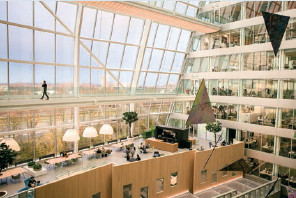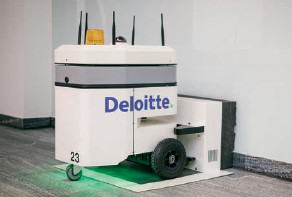An office building in Amsterdam has been designed as a zero-carbonbuilding that occasionally generates more power than it consumes and uses a host of smart technologies to create adaptable and intelligent workspaces.Just under a third of the world’s energy is consumed by buildings that are responsible for about a fifth of global greenhouse gas emissions, according to the International Panel on Climate Change. More worrying, their use of energy could double or even treble by 2050, as billions of people acquire adequate housing and access to electricity. But widespread use of best practices and technologies could stabilise energy use by buildings by 2050, or even reduce it.In practice, buildings offer highly cost-effective opportunities to curb energy demand. The know-how exists to
Topics:
Perspectives Pictet considers the following as important: In Conversation With, Pictet Report, Pictet Report Winter 2018, Smart building, Sustainable building, urban evolution
This could be interesting, too:
Perspectives Pictet writes House View, October 2020
Perspectives Pictet writes Weekly View – Reality check
Perspectives Pictet writes Exceptional Swiss hospitality and haute cuisine
Jessica Martin writes On the ground in over 80 countries – neutral, impartial and independent
An office building in Amsterdam has been designed as a zero-carbonbuilding that occasionally generates more power than it consumes and uses a host of smart technologies to create adaptable and intelligent workspaces.
Just under a third of the world’s energy is consumed by buildings that are responsible for about a fifth of global greenhouse gas emissions, according to the International Panel on Climate Change. More worrying, their use of energy could double or even treble by 2050, as billions of people acquire adequate housing and access to electricity. But widespread use of best practices and technologies could stabilise energy use by buildings by 2050, or even reduce it.
In practice, buildings offer highly cost-effective opportunities to curb energy demand. The know-how exists to construct very low- and zero-energy buildings, often at little marginal investment cost. Such techniques combined with numerous smart technologies have led to recognition of The Edge, an Amsterdam office block, which was rated as one of the most sustainable office buildings in the world when it was completed in 2015.
The Edge was commissioned by Deloitte, the global accountancy and consultancy firm, and designed by PLP Architecture, a London-based group behind many innovative buildings. The commission had two aims: to consolidate the firm’s Amsterdam offices, which were then spread around several buildings throughout the city; and to create a smart building that would act as a catalyst for Deloitte’s transition to the digital age and new ways of working.
‘One great advantage of the commission was that Deloitte would occupy most of the building on a 15-year contract,’ says Ron Bakker, the architect. ‘This is quite long for a commercial development, but it meant that the firm would be able to benefit from additional investment in sustainability. Anything with a payback of under ten years was approved – effectively making the many energy-saving features feasible.’
At the heart of The Edge’s design is a large atrium, criss-crossed with bridges and lift cores and home to a restaurant and café. It creates a series of social environments in which people can meet and talk to each other to foster new patterns of working. Already popular with staff, it is like a sort of giant amphitheatre visible from the surrounding offices on three sides.

The Edge uses 70 per cent less electricity than modern Dutch office buildings and generates more energy than it uses because of two design features:
- The largest array of solar panels for any European office building covers its roof, the south-facing façade and rented roof-space nearby.
- An aquifer thermal energy storage system 130 metres below the building functions like a battery, holding the temperature steady around 13–14 oC. This is warm enough for heating in the winter and cool enough for cooling in summer – no other energy is required for heating or cooling.
The low level of energy consumption reflects the high standards of insulation built into The Edge, smart building design and efficient lighting. The atrium has a north-facing glass façade that has spectacular views and lets in steady natural light.
The other three sides of the building have the office accommodation and are faced by concrete with plenty of insulation and cladding. The thick walls catch the sun through the day, but their deeply recessed windows have small openings that only light up the offices when the sun shines straight through. And the solar panels on the southern façade provide enough electricity to power all smartphones, laptops and electric cars.
The Internet of Things plays a vital role in conserving energy, with some 28,000 sensors in the building to monitor occupancy, movement, lighting, humidity and temperature. Lighting is provided by low-energy LEDs in the ceiling, which require so little electricity that they can be powered by the ethernet cables that carry data for the internet. There are also fine blue water tubes in the ceiling that can adjust the heating or cooling, and each individual fixture in the ceiling can be controlled by computer or a mobile app without opening the panels. The building systems are designed to maximise its efficiency.
A feature popular with visitors is Sam, an experimental mobile robot that provides out-of-hours security and can use the lifts to move between floors. It creates a more pleasant environment than using batteries of cameras – and if it finds someone who is not expected, it can ask for ID while the control room looks on.

Like many professional services firms, most of Deloitte’s staff work outside the office, usually in clients’ buildings. So The Edge has just 1,000 workspaces for its 2,500 employees that are allocated via an app on their smartphones. They can use it to find free desks where they can work with other colleagues, locate parking spaces and report problems to maintenance. There are nodesktop computers, which would anchor employees to individual offices – everyone works on their laptops with Wi-Fi connections.
‘Dutch people choose to work in sustainable buildings,’ says Ron Bakker, ‘so The Edge has proved an effective attraction for staff recruits. And they enjoy being able to use the app to influence their working environments in line with their needs and desires – something that research has shown increases activity.’
There are many other sustainability features in The Edge’s design. For example, rain water is collected on the sloping roof to flush toilets and irrigate green spaces in the atrium and surrounding gardens. The atrium recycles air from the offices for air conditioning its space and passes it through a heat exchanger to make use of any warmth before discharging it outside the building.
Its sustainability was recognised in 2016 when it won an award from BREEAM, the organisation which certifies the sustainability of buildings and has certified more than 560,000 developments in 76 countries. The Edge scored an outstanding rating of 98.36 per cent, which was then the world’s highest rating for a newly constructed office building.
BREEAM said that its rating reflected the Edge’s integration of numerous smart technologies to create adaptable and intelligent work spaces. ‘The building demonstrates that the pursuit of a vibrant and collaborative working environment can be combined successfully with achieving the highest levels of sustainability.’
It is perhaps a sign of the speed of innovation in office sustainability that Bloomberg’s new European HQ in London has subsequently achieved a higher score in the awards. And the attractiveness of such buildings quickly paid off for OVG Real Estate, the developer of The Edge, says Ron Bakker.
‘The Edge was a high-cost building, though not excessively so by Dutch standards. But OVG had no trouble selling it in 2014, before it was fully open, to German fund manager Deka Real Estate which could see that its sustainability and smart features added business value to the property.’
